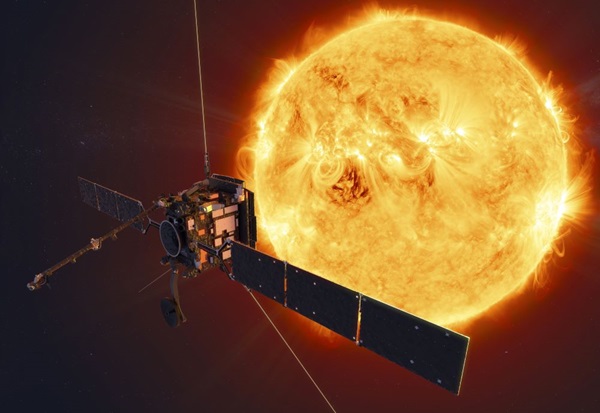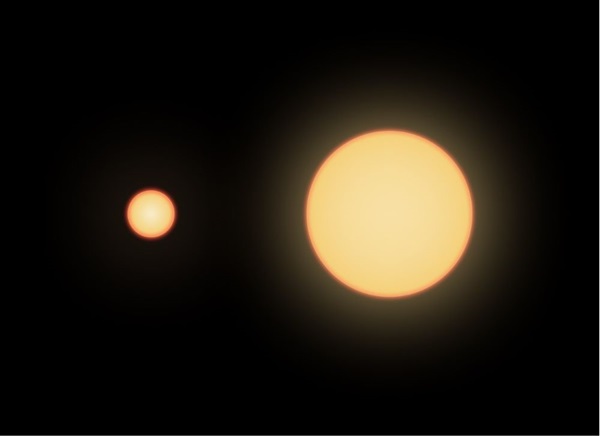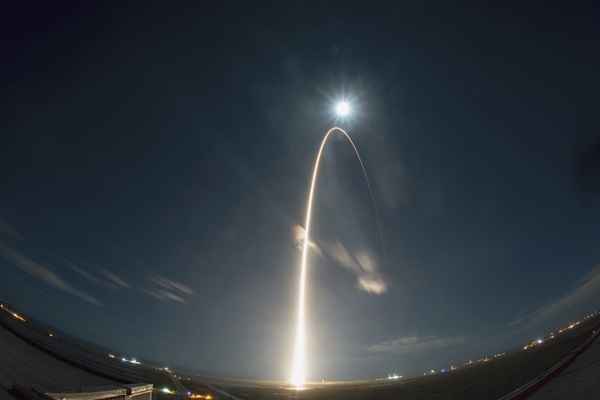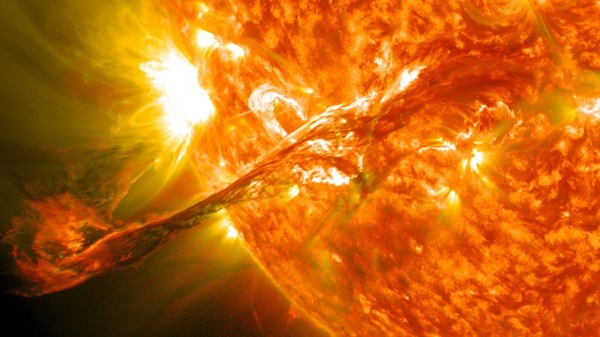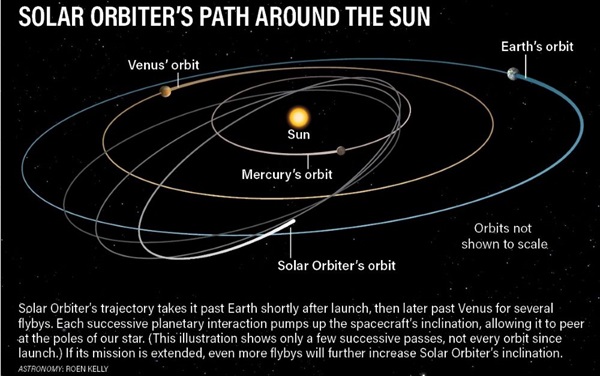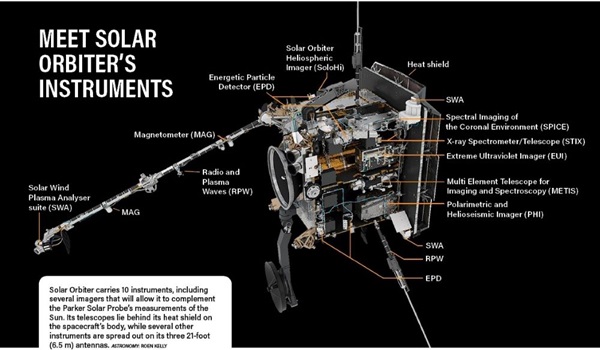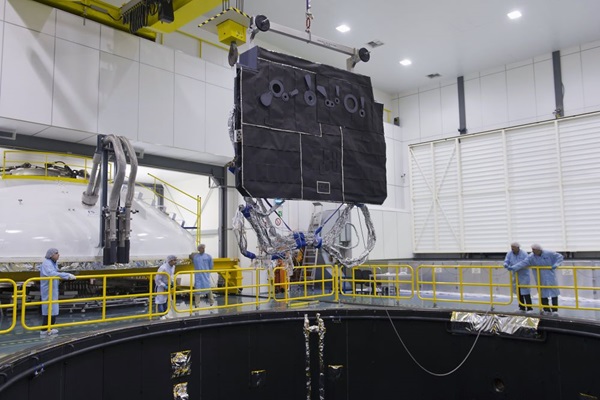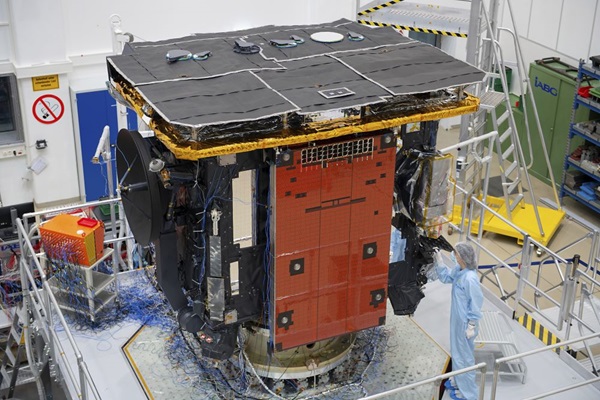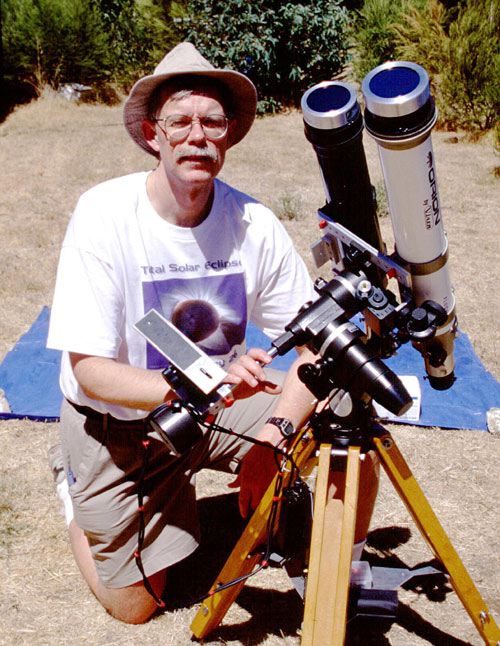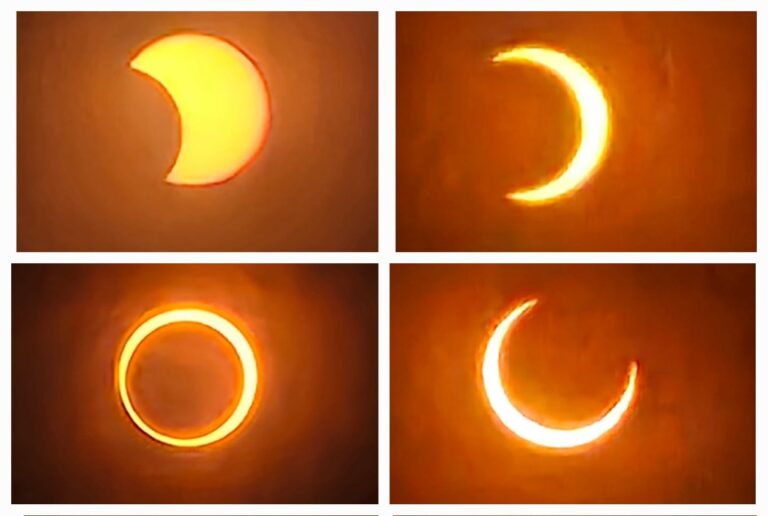Key Takeaways:
In February 2020, scientists from 10 nations took the first step on a journey to our star more daring than Icarus’ wildest dreams. The European Space Agency (ESA) and NASA’s Solar Orbiter carries protections far tougher than waxen wings, yet even its bristling high-tech design owes a debt to our distant, cave-dwelling ancestors.
What we know about our Sun
More than 4.6 billion years old, the Sun is the heart of our solar system. A stable G-type star on the cusp of middle age, it is fast approaching the halfway point in an evolution that has seen life sprout on at least one of its planetary retinue. More than 300,000 times more massive than Earth and 864,400 miles (1.4 million kilometers) in diameter, the Sun holds 99.86 percent of the mass in the solar system. Its unwavering emergence at dawn in the east, its daily transit across the sky, and its disappearance in the west at nightfall have earned it great spiritual importance throughout history. The Sun’s life-giving warmth and timekeeping beneficence objectified it for veneration from the ancient Near East to the pre-Columbian Americas.
Yet only recently have astronomers and physicists come to theoretical grips with the Sun’s true nature: a broiling sphere of plasma comprising three-quarters hydrogen and one-quarter helium, and the singular reason for earthly existence. Instruments on the ground and in space have opened an insightful window into its throbbing interior. A core more than 13 times denser than lead and 25 times wider than Earth generates temperatures of 15.6 million kelvins, hot enough to fuse hydrogen into helium and transform millions of tons of matter into energy every second. Temperatures cool to 5,800 kelvins (9,980 degrees Fahrenheit [5,527 degrees Celsius]) at its visible surface (the photosphere), then climb precipitously from 10,000 to 1 million-plus kelvins in its glowing corona, which appears like an effervescent veil during solar eclipses.
Spacecraft have watched the Sun from afar for five decades, spotting shock waves, flares, and coronal mass ejections (CMEs) that unleash huge quantities of plasma and internal magnetism into the bubblelike heliosphere that surrounds the planets. The joint ESA/NASA Solar and Heliospheric Observatory (SOHO) and NASA’s Transition Region and Coronal Explorer showed the Sun’s energetic vigor ebbs and flows in tight lockstep with each 11-year cycle of solar activity. Ultraviolet data from SOHO and the Japanese Institute of Space and Astronautical Science’s Yohkoh probe revealed the role of thin, magnetized loops in heating and accelerating coronal plasmas. NASA’s Solar Dynamics Observatory sharpened our awareness of how this magnetism is created, stored, and released.
Two decades ago, ESA and NASA’s Ulysses probe flew outside the ecliptic plane in which the planets orbit and found surprising uniformity across the Sun’s global magnetic field. But the probe never got closer than 1.2 astronomical units. (One astronomical unit, or AU, is the average Earth-Sun distance.) Solar Orbiter will scrutinize lower latitudes than Ulysses — climbing no higher than 34°, effectively solar midlatitudes. But it will approach to 0.28 AU, offering a ringside seat for this magnetic action.
The immense corpus of spacecraft data has also begun to clarify how coronal plasmas drive the solar wind. This million-mile-per-hour torrent of charged particles streaming from the Sun profoundly affects life on Earth, from disrupting radio communications and upsetting power grids to disabling satellites and triggering aurorae. The twin NASA Solar Terrestrial Relations Observatory probes watched storms brewing on the Sun’s farside, while Ulysses found that the solar wind flows faster at higher latitudes, where it’s discharged along open magnetic field lines through holes in the corona at the Sun’s poles. And although SOHO provides some early warning for incoming storms, Solar Orbiter’s close-up view of the Sun and state-of-the-art science toolkit allow it to better predict the effects the solar storms will have when they reach us.
A Solar Orbiter is born
In 1998, the success of Ulysses and SOHO prompted recommendations for a new European solar mission. It would study the Sun from beyond the ecliptic, as Ulysses did, using high-spatial-resolution imaging sensors, as SOHO had. But it would also fly closer to our star than prior missions, approaching as blisteringly close as 26 million miles (41,843,000 km), just 0.28 AU — inside the orbit of Mercury. There, incident temperatures on the spacecraft would surpass 968 F (520 C).
ESA selected Solar Orbiter to proceed in 2000 with a launch date between 2013 and 2015, but grim fiscal reality had other ideas. In 2011, Solar Orbiter was named Europe’s first medium-class Cosmic Vision mission. The same year, a partnership with NASA brought an added dowry of an Atlas V rocket and funding for additional scientific instrumentation.
Solar Orbiter was built alongside ESA’s Mercury-bound BepiColombo spacecraft, which launched in October 2018, to leverage design synergy between them. The mission’s multilayered insulation, heat pipes, batteries, data-handling systems, and parts of the high-gain antenna draw directly from BepiColombo, while other elements (including radiators and heat shielding) are unique to Solar Orbiter.
The mission was planned for launch sometime after 2017 — a date which inexorably slid back as prime contractor Astrium (now part of Airbus) and industrial teams across Europe labored to ensure the spacecraft could survive its perilous journey and accomplish its scientific goals. Mission scientists met frequently with ESA and Airbus to clarify Solar Orbiter’s unique requirements during construction, according to Chris Owen of University College London (UCL), principal investigator for the Solar Wind Plasma Analyser. “The original philosophy to reuse as much of the BepiColombo spacecraft and subsystems as possible to reduce time and costs was probably a little unrealistic, given the disparate nature of the measurements to be made by the two missions,” Owen says.
A new view
Solar Orbiter will be ideally situated to explore how solar phenomena shape and power the solar wind and how the Sun propels energetic particles into the heliosphere. Flying so close to the Sun, the spacecraft will study the star’s magnetic fields and plasmas in a pristine state, before their properties are altered as they move away from the Sun and through the solar system.
The need for such up-close, “young” measurements was cemented by the twin Helios probes, which found that solar wind ions (atomic nuclei that have had electrons knocked away) are still much hotter than their surroundings as close to the star as just 0.29 AU. Because these ions have not yet thermalized, or radiated away excess heat and energy, researchers want to know the processes responsible for preventing them from cooling.
“We will not get much further in than Helios did,” Owen says. “We will just be able to make much more comprehensive measurements with our modern instrumentation.” Solar Orbiter’s more advanced instruments will make it easier, Owen says, “to understand the physics of the acceleration and heating of the solar wind, before this plasma has undergone significant amounts of evolution.”
After its launch, Solar Orbiter will cruise past Venus in December 2020 and again in August 2021, then execute a nail-biting skim within 270 miles (435 km) of Earth in November 2021. These gravity assist maneuvers (GAMs) will reduce orbital energy and increase inclination, pulling the spacecraft closer to the Sun. In its final orbit, it will circle our star every five months, approaching within 60 solar radii (0.28 AU) at perihelion and drifting to 220 solar radii (1 AU) at aphelion.
Solar Orbiter will exceed 25° in heliographic latitude during its seven-year primary mission. If the mission length is extended to 10 years, additional Venus GAMs between September 2022 and September 2030 will tweak the spacecraft’s orbit to reach latitudes up to 34°.
“Orbital dynamics is a mysterious subject, but it seems that one can’t just keep cranking up the latitude; there is some sort of diminishing return,” says Tim Horbury of Imperial College London, principal investigator for Solar Orbiter’s magnetometer. “I think there is little chance of going a lot higher than we’re planning. I’d be delighted to be wrong.”
Ulysses reached far higher latitudes of 80° but carried no telescopes to image the Sun directly. Additionally, “Ulysses never went closer to the Sun than Earth, so we could never see young solar wind like Orbiter will,” Horbury says. “The telescopes will also make a huge difference. Orbiter is all about the connections between the Sun and space, and with Ulysses, we were flying blind.” Even SOHO’s ultraviolet “sight” only viewed our star from a single perspective; furthermore, its inability to take measurements at different latitudes made it difficult to determine if changes were indeed global.
“We have some generic plans and will tailor them to individual orbits as we get closer,” Horbury says. “Planning for a given orbit starts one year ahead and iterates towards a final detailed plan over six months or so.”
Solar Orbiter’s instruments
Solar Orbiter’s 10 instruments include four in-situ sensors that will run continuously, tracking fields and particles around the spacecraft. Its six remote-sensing detectors will peer directly at the Sun for about 30 days per orbit, using protected apertures cut through its heat shield. Solar Orbiter will work closely with NASA’s Parker Solar Probe. But whereas Parker’s extreme closeness to the Sun — as little as 0.046 AU, squarely inside the corona — promises a fields-and-particles bonanza, its location nixed any chance that it could carry telescopes, thanks to high temperatures. The moderately more benign thermal climes at Solar Orbiter’s distance will allow its imagers to provide additional context for Parker.
Most of the in-situ instruments occupy an extendable boom to minimize interference from spacecraft electronics. The Radio and Plasma Waves instrument from France’s Observatoire de Paris has sensors on the boom and on three monopole antennas, angled 90° apart. UCL’s Solar Wind Plasma Analyser also has detectors on the boom and antennas, plus two more on the main spacecraft body, including a NASA heavy ion sensor. These will study the densities, velocities, temperatures, and compositions of solar wind ions and electrons. “The relative composition of the heavy ions provides a kind of fingerprint, which can be compared with similar information from spectroscopic measurements of the solar surface and thereby confirm the link between the source and the spacecraft,” Owen says. “These measurements should help us reveal how the dynamics of the Sun drive the solar wind and its variability, how that links into interplanetary space and affects Earth’s near-space environment.”
Imperial’s magnetometer will investigate magnetic field evolution, how energetic particles traverse the heliosphere, and why coronal plasmas are so much hotter than the Sun’s surface. The last question has long stumped researchers: “The jury is still out as to whether waves, nanoflares, or something else is doing the extra heating,” Horbury says. “It’s probably a combination of lots of things, but we need to know the contribution of each and how they vary. Helios has given us some strong hints that nanoflares must be playing a role and, with Orbiter, we’ll be able to tie those things down by looking at the solar plasma and fields in unprecedented detail, while looking remotely at the source regions and linking the two.”
Solar Orbiter’s instruments have been a decade in the making. Imperial also contributed magnetometers to Ulysses and Cassini. “There’s a lot of know-how in the design of a sensitive scientific instrument and this flow from one mission to the next, through the expertise of the engineering team,” Horbury says. “It would have been far harder to start from scratch.”
Solar Orbiter also includes many novel technologies. “Perhaps the most significant is the way the sensor is run,” Horbury explains. Traditionally, he says, magnetometers use analog electronics to measure influences from an external magnetic field on the instrument’s internal field. But for Solar Orbiter, “we’d been funded to develop a new digital version” of the magnetometer. “We’ve also had to develop an entirely new set of software that runs on the instrument to talk to the spacecraft, which is far more complex than anything we’ve done before,” he says.
The last in-situ instrument, the Energetic Particle Detector from the University of Alcalá in Spain, resides on Solar Orbiter’s main bus. Its five sensors will monitor suprathermal (fast-moving) and energetic particles from helium to iron to identify where they come from, what accelerates them, and how they propagate through space. It includes a NASA-funded suprathermal ion spectrograph built by the Johns Hopkins University Applied Physics Laboratory.
Elsewhere on the bus, the six remote-sensing instruments represent multiple nations. The Royal Observatory of Belgium’s Extreme Ultraviolet Imager uses high-resolution telescopes and full-Sun imagers to analyze the photosphere and the corona, providing context for Italy’s Multi Element Telescope for Imaging and Spectroscopy (METIS) coronagraph and the NASA-funded Spectral Imaging of the Coronal Environment (SPICE) imager. Supplied by the Astronomical Observatory of Turin, METIS will examine the corona and inner heliosphere at visible and ultraviolet wavelengths. Meanwhile, SPICE performs extreme ultraviolet inspections of the solar atmosphere and solar wind.

What we can learn from the life cycles of stars? Astronomy’s free downloadable eBook, Stars: The galaxy’s building blocks contains everything you need to know about how stars live, die, and change their galactic homes over time.
Although several instruments will sit in direct sunlight, most of Solar Orbiter’s payload will cower behind what could be unflinchingly described as the “mother of all heat shields.” Ten feet long and 8 feet wide (3 meters by 2.4 meters), this bulky edifice will guard against withering highs of 968 F (520 C) at perihelion and frigid lows of –220 F (–140 C) at aphelion, all the while keeping the sensors comfortably at room temperature. The 15-inch-thick (38 centimeters) shield comprises multiple sheets of high-temperature insulation and titanium and will direct heat laterally into space via gaps between its main layers.
However, to continually protect the spacecraft, the shield needs to maintain a comfortable temperature range and avoid shedding material, outgassing vapors, or building up static charge over years of exposure to harsh solar radiation. To solve the problem, the Irish firm Enbio, based in north Dublin, adapted its methodology for coating titanium medical implants to create a thermal material called SolarBlack. This black calcium phosphate is bonded directly onto the shield’s titanium skin, replacing its natural oxide surface. The SolarBlack material incorporates charcoal produced through charring animal bones, once used by our prehistoric ancestors as a pigment for cave art.
The remote-sensing instruments will peep through long, titanium-walled cylinders in the shield, which are covered by optical baffles of protective glass or beryllium. Trapdoors will snap shut if heat-induced damage begins to occur. Solar Orbiter’s high-gain antenna can be rotated above or behind the shield to afford it protection from the heat flux. The spacecraft’s elliptical orbit will impose unusual thermal demands on the antenna, rendering its downlink capability somewhat sporadic, so data will be stored onboard and transmitted later. The solar arrays, too, must be carefully angled to avoid ruining their optics or the glue that holds their cells in place.
A group effort
Building and testing this complex spacecraft across eight countries underscores the significance of international collaboration on Europe’s most ambitious solar science endeavor. “Relationships within the team have been excellent and some strong bonds have been made that will be used for future collaborations,” Owen says. “The international nature of what we have done, and the mission as a whole, is critical, since the costs involved would probably not have been taken on by a single European nation.”
Ultimately, the story of Solar Orbiter is one of collaboration. Not only will the mission complement existing solar probes and datasets, its design also reflects the immense effort numerous international teams put into building a single spacecraft with every system working in concert.
“There is an unusual level of mutual understanding on this mission,” Owen says. “All instruments have worked very hard to accommodate the environmental requirements of the others. We all recognize that the big advances will certainly come from the full combined payload. We have mechanisms in place to share data between instruments on the spacecraft, so it can autonomously recognize events and record the best or most appropriate data. We all agreed in principle early on that if one instrument made a strong science case for operating for some period in a way that did not necessarily work for the rest of us, we would seek to accommodate this for the benefit of the overall combined science return.”

